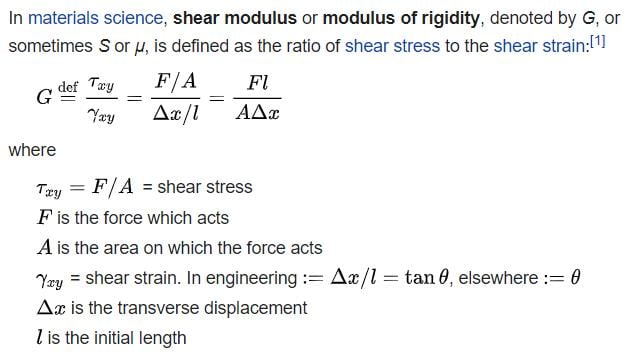Similarly the loss modulus G or E of a material is the ratio of the viscous out of phase component. Therefore Cleft orGorN right fracShearstressShearstrain fractau phi Modulus of Elasticity or Youngs Modulus.
Schematic Diagrams To Illustrate The Definitions Of Young S Modulus Download Scientific Diagram
So option 4 is correct.

Shear modulus (g) is defined as the ratio of. Modulus of rigidity G is the elastic coefficient when a shear force is applied resulting in lateral deformation. The modulus of rigidity gives as the ratio is mathematically given by the ratio of the shearing stress and strain of a body. Youngs Modulus from shear modulus can be obtained via the Poissons ratio and is represented as E 2 G 1 𝛎 or youngs_modulus 2 Shear Modulus 1 Poissons ratio.
All three elastic constants can be interrelated by deriving a relation between them known as the Elastic constant formula. Modulus of rigidity is called as shear modulus and it measure the rigidity of material. The shear modulus G is defined as the ratio of shear stress to engineering shear strain on the loading plane where.
The shear modulus G is also known as the rigidity modulus and is equivalent to the 2nd Lamé constant m mentioned in books on continuum theory. Shear modulus is the slope of the linear elastic region of the shear stressstrain curve and Poissons ratio is defined as the ratio of the lateral and axial strain. K Bulk Modulus.
The ratio of shear stress to the corresponding shear strain within the elastic limit is known as Modulus of Rigidity or Shear Modulus. The shear modulus or modulus of rigidity G describes an objects tendency to shear the deformation of shape at constant volume when acted upon by opposing forces. Modulus of Rigidity - G - Shear Modulus is the coefficient of elasticity for a shearing force.
E Youngs Modulus also known as Modulus of Elasticity. The elastic moduli are measures of stiffness. Shear modulus is the coefficient of elasticity for a shearing force.
Modulus of rigidity is also known as shear modulus on a material. It is denoted by C or G or N. The stress relaxation modulus is the ratio of the stress remaining at time after a step strain was applied at time.
The ratio of shear stress to shear strain. From the above discussion the shear modulus of elasticity is the ratio of shearing stress and shearing strain. The ratio of shear stress to the corresponding shear strain within the elastic limit is known as Modulus of Rigidity or Shear Modulus.
Modulus of rigidity or shear modulus. And E Youngs modulus by the following for isotropic solids those for which properties are independent of direction. Shear strains developed during earthquakes may increase from about 10-3 in small earthquakes to 10-1 for large motions.
It is denoted by G. The shear modulus is part of the derivation of viscosity. It can be experimentally determined from the slope of a stress-strain curve created during tensile tests conducted on a sample of the material.
This valuable property tells us in advance how resistant a material is to shearing deformation. Shear Modulus η Shear Modulus of Elasticity is one of the mechanical characteristics of solids that may be measured. Modulus of rigidity shear modulus is ratio of shear stress to shear strain within the elastic limit.
The shear modulus is the earths material response to the shear deformation. It is often referred to simply as the elastic modulus. The ratio of shear stress to shear strain in a body is given by the shear modulus of material.
Often denoted by G. Shear modulus also known as Modulus of rigidity is the measure of the rigidity of the body given by the ratio of shear stress to shear strain. G shear stress shear strain.
It is the ratio of shear stress to the displacement per unit sample length shear strain. But youngs modulus E and the Poisson ratio𝝂 are known as the independent elastic constants and they can be obtained by performing the experiments. Meanwhile the maximum dynamic shear modulus Gmax.
For visco-elastic solids G t displaystyle Glefttright converges to the equilibrium shear modulus 4 G displaystyle G. Which is the time-dependent generalization of Hookes law. G as the shear modulus.
It is defined as the ratio of shear stress and shear strain. G Shear Modulus also known as Modulus of Rigidity. It is one of the most important mechanical properties of solids.
The following equations demonstrate the relationship between the different elastic constants where. The latter found that the ratio of G from laboratory tests to G from field tests decreases markedly with increasing shear stiffness. It is defined as shear stress over shear strain.
If a material is very resistant to attempted shearing then it will transmit the shear energy very quickly. Elastic or storage modulus G or E of a material defined as the ratio of the elastic in-phase stress to strain. This is denoted by C or G or N.
Relation to elastic moduli in isotropic solids Poissons ratio is related to elastic moduli K also called B the bulk modulus. Youngs modulus and bulk modulus are two more elastic moduli. The storage modulus relates to the materials ability to store energy elastically.
The dynamic shear modulus G in the various strain ranges of undisturbed silty clay and silt increases regularly with the buried depth H. It is defined as the ratio of shear stress to the displacement per unit sample length shear strain.

Calculating Shear Modulus Ansys Learning Forum

Shear Modulus An Overview Sciencedirect Topics
What Is The Relation Between Young S Modulus And Shear Modulus Quora

Relation B W Young Modulus Shear Modulus Bulk Modulus Poisson S Ratio Youtube
What Is The Equation That Relates Shear Modulus And Bulk Modulus To Young S Modulus Quora